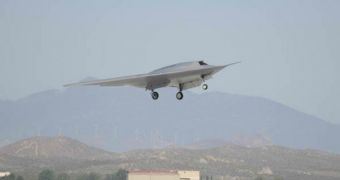An advanced unmanned aerial vehicle from The Boeing Company took to the skies for the first time on April 27, after having successfully completed a series of taxis flights. The robot has extreme capabilities, and is heralded as the next innovation in unmanned surveillance and combat.
The new aircraft's first flight lasted for about 17 minutes, and was carried out above the American space agency's Dryden Flight Research Center. The facility is immediately adjacent to the Edwards Air Force Base (EAFB) in California.
According to officials at Boeing, the new tests were only possible after the ground guidance, navigation and control and verified mission planning, pilot interface and operational procedures were validated in high-speed taxi tests carried out this March.
As soon as engineers saw that these systems were operational, they took a chance, and declared the UAV to be ready for its first stand-alone flight. At this point, the Phantom Ray is only a demonstrator.
This means that – if it handles itself well – it may enter larger-scale production, for customers such as the US Air Force. The advanced machine is about the size of a regular fighter jet, which is pretty impressive for an unmanned drone.
Interestingly, Boeing engineers designed an aircraft that is capable of conducting autonomous aerial refueling missions, ground attacks and air surveillance from the same platform. During the April 27 flight, the vehicle reached a speed of 178 knots, and an altitude of 2,290 meters (7,500 feet).
Over the next few weeks, ground teams will carry out additional flights, during which they will test numerous other systems aboard the Phantom Ray. They also need to get a grip on the aircraft's full potential.
“This day has been two-and-a-half years in the making. It's the beginning of providing our customers with a test bed to develop future unmanned systems technology, and a testament to the capabilities resident within Boeing,” said the President of Boeing Phantom Works, Darryl Davis.
“Just as follow-on tests will expand Phantom Ray's flight envelope, they also will help Boeing expand its presence in the unmanned systems market,” the official goes on to say.
“The first flight moves us farther into the next phase of unmanned aircraft. Autonomous, fighter-sized unmanned aircraft are real, and the UA[V] bar has been raised. Now I’m eager to see how high that bar will go,” adds the Phantom Ray program manager, Craig Brown.

 14 DAY TRIAL //
14 DAY TRIAL //